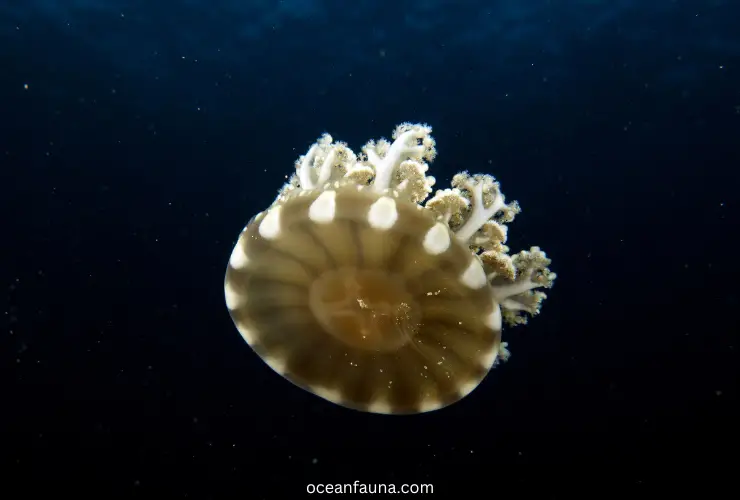Upside-down jellyfish are known as Cassiopea, a genus that belongs to the true jellyfish. It’s the one and only member of the family of Cassiopeidae. There are more than eight species of jellyfish that belong to this member.
These unique creatures are a sight with their upside-down posture and pulsating bell-like structures. Moreover, upside-down jellyfish are found in shallow marine waters. These species of jellyfish are known for their symbiotic relationship with photosynthetic algae.
Have you ever seen a jellyfish upside down? Or better yet, have you ever heard of the upside-down jellyfish? If not, then you’re in for a treat. So, come on in, and let’s dive deep into the world of the upside-down jellyfish. Trust us; it’s going to be a wildlife ride.
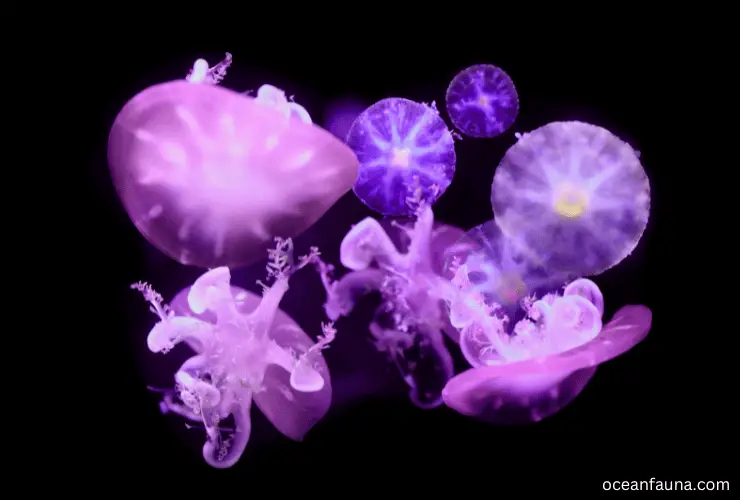
About Upside-Down Jellyfish – A Quick Biology
Here is a quick biology table that covers everything related to the biography of upside-down jellyfish in a matter of seconds!
| Parameters | Details |
| Scientific name | Cassiopea xamachana |
| Kingdom | Animalia |
| Families | Cassiopeidae (Agassiz, 1862) |
| Genus | Cassiopea (Péron & Lesueur, 1809) |
| Phylum | Cnidaria |
| Class | Scyphozoa |
| Order | Rhizostomeae |
| Species | Cassiopea xamachanaCassiopea ornataCassiopea ndrosiaCassiopea mertensiCassiopea medusaCassiopea maremetensCassiopea frondosaCassiopea depressaCassiopea andromeda |
| Habitat | These species of jellyfish are found all over the world in warmer coastal regions. |
| Diet | Their 90 percent diet is based on nutrients in algae and their 10 percent diet is based on zooplankton. |
| Life Span | 4 years or less |
| Geographical range | Their geographical range is from the Caribbean, Southern Florida, and Hawaii to the Indo-Pacific ocean. |
| Weight | The weight of upside-down jellyfish varies. It depends on its size and species. For example, Cassiopeia xamachana is a common species of jellyfish. It weighs around 200-300 grams. Many other species weigh in kilograms. |
| Size | Upside-down jellyfish sizes also vary. However, they can grow 30 cm easily in diameter. |
Some Amazing Facts About Upside-Down Jellyfish
Here are some facts about upside-down jellyfish that will amaze you:
- The bodies of upside-down jellyfish contain 95 percent water.
- It looks like a flower with its upside down.
- Upside-Down Jellyfish are not strong swimmers. They rely on water currents to move.
- These jellyfish can regenerate lost body parts.
- The upside-down jellyfish can change color according to sunlight.
- They have a low metabolic rate and can survive in low-oxygen environments.
- These jellyfish can sense their surroundings through touch and taste.
- Upside-Down Jellyfish are not social creatures and tend to live alone.
- They can filter large amounts of water to capture food.
Upside-Down Jellyfish Encyclopedia: Top 10 Crazy Facts That Will Blow Your Mind
Get ready to flip your perspective on jellyfish with these top 10 facts about the mesmerizing upside-down jellyfish.
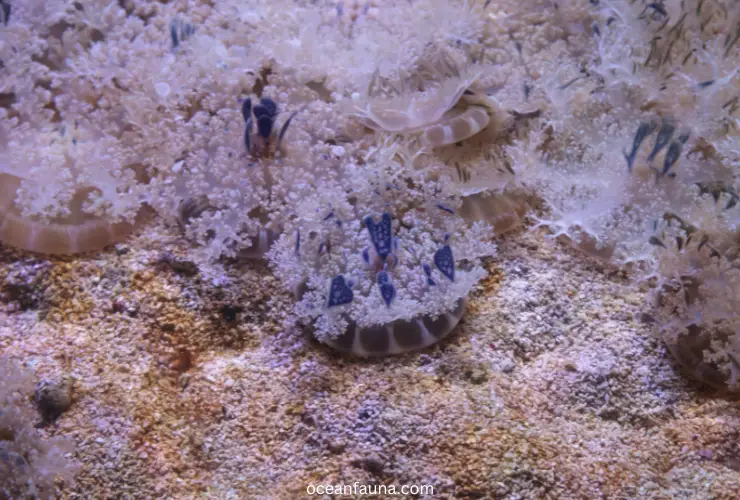
Description and Anatomy of Upside-Down Jellyfish
The upside-down jellyfish are benthic creatures. They are commonly found on muddy or sandy substrates in shallow tropical waters. These species of jellyfish have flattened, disk-shaped bodies. There are more than 30 species that are known to lie under this member.
However, 8 to 10 are only recognized and verified as the species of this member. These species of jellyfish have flattened bell-shaped bodies. The exumbrella or upper surface of the jellyfish is smooth and dome-shaped. Along with it, they have a central depression used for attachment purposes.
Overall, the upside-down jellyfish has a unique anatomy and life cycle. This allows it to thrive in its benthic environment. Its symbiotic relationship makes it a fascinating subject for marine biologists and enthusiasts.
Physical Characteristics / Appearance of Upside-Down Jellyfish
The name of this jellyfish describes its appearance. Their colors vary depending on their species and habitat. They can be green, white, gray/blue, and brown. They have distinct coloration due to symbiotic zooxanthellae.
The adult medusa has four branching tentacles for feeding, aided by the dinoflagellates’ photosynthesis. The dome-shaped exumbrella is mainly used for attachment as they remain sedentary most of their lifecycle.
The jellyfish may also have a bumpy or lumpy appearance. It is due to the presence of small projections on the surface of the bell. Some species may have a translucent or transparent appearance, with a white or cream-colored bell.
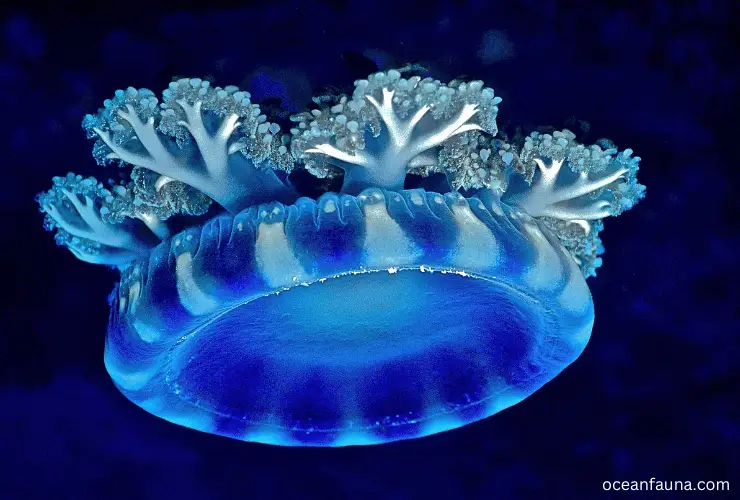
Behavior of Upside-Down Jellyfish
Here are some special and unusual behaviors of the species of upside-down jellyfish:
Symbiotic Relationship
The Cassiopea xamachana’s behavior and habitat depend largely on its symbiotic relationship with Symbiodinium microadriaticum. This behavior requires sunlight to produce nutrients.
The jellyfish needs to be upside-down in shallow waters to get enough sunlight. The jellyfish host zooxanthellae in their tissues. It allows for photosynthesis to occur just like most corals.
The upside-down jellyfish obtains a significant portion of its diet easily through the symbiotic relationship. The rest of the diet comes from hunting with stinging cells or nematocysts. This is another common hunting behavior in all species of upside-down jellyfish.
Sleep State Behavior
Eurekalert has defined one of the upside-down jellyfish’s unique, ancient, and amazing behaviors. They found that some Cassiopeia species have been observed entering a sleep-like state.
In this state, they decrease their pulsation rates and thus, the response to stimuli will also be decreased. After sleep deprivation, they display a compensatory rebound sleep.
Habitat, Range, And Distribution of Upside-Down Jellyfish
Upside-down jellyfish mostly live in warmer coastal regions. These are found all over the world. The regions may include the following:
- Micronesia
- The southeastern tip of the United States (Florida Keys)
- Bermuda
- Caribbean Sea
- Western Atlantic Ocean
- Hawaiian waters
- Mediterranean waters
- Red Sea
The species lying under upside-down jellyfish are found in mudflats, canals, and shallow mangrove swamps. They prefer habitats with calm waters. These jellyfish typically dwell upside-down on the seafloor. Hence, they got their common name from this living habitat.
Upside-down jellyfish depends on photosynthetic dinoflagellates. It is because they have a symbiotic relationship with them. Therefore, they inhabit shallow marine waters with enough light to sustain their energy source. Some species of Cassiopeia are even found in estuaries and brackish water.
“Mangrove jellyfish” is a common name for upside-down jellyfish. It is because they settle in mangrove leaves with the help of muddy substrata. Scyphistoma of the jellyfish is scarce from late November to early June but can be found in mid to late summer.
Strobilating scyphistomae and benthic-dwelling ephyra of the upside-down jellyfish were observed abundantly from late June until the fall end. But almost none were seen in the winter or spring. Thus, upside-down jellyfish have a distinct habitat and range.
Feeding Habits / Diet of Upside-Down Jellyfish
According to Quora colleagues, upside-down jellyfish are carnivorous. It means they love to eat other invertebrates. They have a mixed diet that consists of plankton, small fish, and crustaceans. They mostly feed on zooplankton and phytoplankton found in the water column.
They also use their tentacles to capture small organisms that swim or drift too close to them. Nematocysts help them capture their prey. They obtain nutrients not only from their prey but also through photosynthesis. We have described it in our other section.
The upside-down jellyfish are opportunistic feeders. It means they will eat whatever is available to them. They do not have a well-developed digestive system. So, they need to digest their food quickly. The digestive process starts in the stomach, where the food is broken down. It is then transported to the mesenteries, where the nutrients are absorbed.
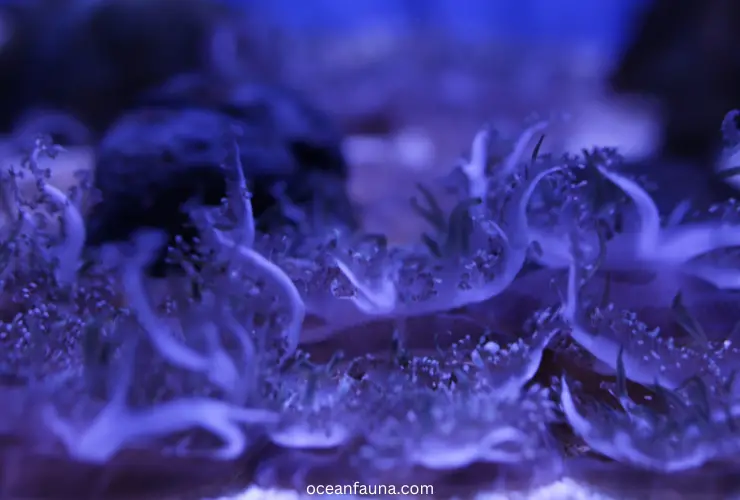
The Defense Mechanism of Upside-Down Jellyfish
These species of upside-down jellyfish have a mild sting. It is due to their primarily photosynthetic behavior. However, sensitive individuals may experience a stronger reaction due to these stings.
According to NCBI research, jellyfish excrete their stinging cells with the help of “cassiosomes“. The cassiosomes are mucus-like masses. The people swimming near the jellyfish may get stung by them with their stinging cells. (Source)
Phys’ organization has also solved this mysterious defense mechanism of upside-down jellyfish. The jellyfish stings cause a red rash-like irritation on the exceptionally itchy skin. Dorippe frascone crabs sometimes pick and carry the jellyfish on their backs. They use upside-down jellyfish to defend against potential predators. (Source)
Life Cycle and Reproduction System of Upside-Down Jellyfish
Both sexual and asexual reproduction characterize the lifecycle of the upside-down jellyfish. In sexual reproduction, males release their gametes into the water, while females take them in for fertilization. The fertilized eggs develop into free-swimming larvae, which settle on the substrate and grow into polyps.
The polyps undergo asexual reproduction through budding, where new polyps grow from the parent polyp. These newly formed polyps then develop into medusae or jellyfish, the mature and dominant stage of the upside-down jellyfish’s lifecycle.
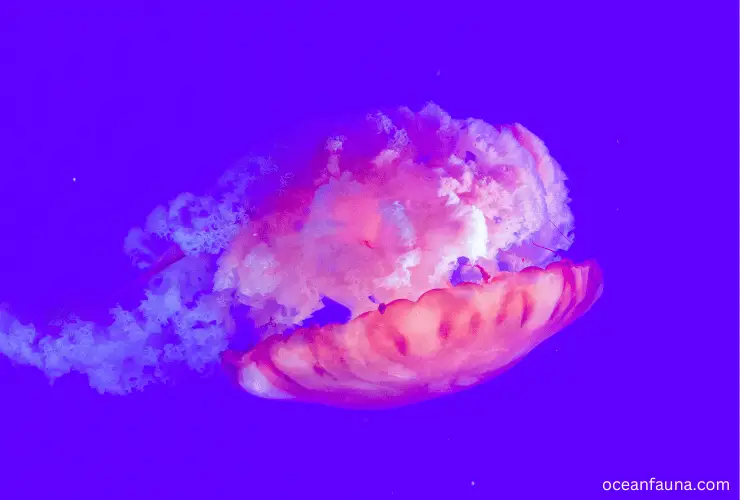
During the medusa phase, the jellyfish produce gametes that lead to sexual reproduction. In addition to sexual and asexual reproduction, the upside-down jellyfish can undergo transdifferentiation. This is a process where the medusa stage transforms into the polyp stage.
This unique reproductive system allows the jellyfish to adapt to changing environmental conditions and reproduce efficiently. The upside-down jellyfish has a fascinating life cycle and reproductive system. It contributes to their survival and adaptation to different environments.
The Lifespan of Upside-Down Jellyfish
The lifespan of upside-down jellyfish is not well documented in the scientific literature. However, it is estimated to be around 1 to 2 years old in the wild. However, they can live for up to 4 years in a captive environment.
The lifespan may be influenced by environmental factors such as
- Temperature
- Water quality and
- Food availability.
Younger individuals may grow more quickly and have a higher reproductive output than older individuals. The medusa stage (adult phase) is the most vulnerable and is prone to predation and disease. The upside-down jellyfish may also experience tissue damage or degradation as they age. It can impact their overall health and longevity.
Cardiovascular And Nervous System of Upside-Down Jellyfish
Cardiovascular System
The upside-down jellyfish has a simple cardiovascular system. It includes a ring-shaped and radial canal extending into the bell’s lobes. The canals are lined with cilia that help move fluid through the system. The jellyfish lacks a true heart or circulatory system. It relies on diffusion to transport nutrients and oxygen.
Nervous system
Again, the upside-down jellyfish has a relatively simple nervous system. It includes a nerve net located in the epidermis, a rhopalial nerve ring around the margin of the bell, and four rhopalia.
Rhopalia are sensory structures that include light-sensitive ocelli and statocysts. These statocysts help the jellyfish maintain balance. The nervous system allows the jellyfish to detect and respond to changes in its environment, such as light and food.
Species of Upside-Down Jellyfish
The World Register of Marine Species has found the following species of upside-down jellyfish:
| Species name | Who found it? | When was it founded? | Where it was founded? |
| Cassiopea xamachana | Bigelow | 1892 | It was first founded in the Northern Atlantic area of the West Indies and the Caribbean Sea. |
| Cassiopea ornata | Haeckel | 1880 | It was found in the Philippines, Okinawa, Palau, and the Pacific Ocean. |
| Cassiopea ndrosia | Agassiz & Mayer | 1899 | It was found in the Pacific Ocean, Australia, and Fiji. |
| Cassiopea mertensi | Brandt | 1838 | It was first found in the Pacific Ocean and Southern Micronesia. |
| Cassiopea medusa | Light | 1914 | It was found in the Pacific ocean. The Palau regions and the Philippines are also their places. |
| Cassiopea maremetens | Gershwin, Zeidler, and Davie | 2010 | It was found in the western Pacific Ocean and the regions of the Australian Coasts. |
| Cassiopea frondosa | Pallas | 1774 | It was found in the Western Atlantic oceans and the Caribbean Sea. |
| Cassiopea depressa | Haeckel | 1890 | It was found in the western Indian Ocean and off the coasts of Africa. |
| Cassiopea andromeda | Forsskål | 1775 | It was found in the Indo-Pacific oceans. It was also introduced in the Mediterranean. |
Predators of Upside-Down Jellyfish
Here is a table of the biggest enemies/predators of upside-down jellyfish:
| Predators | Species | Details |
| Spotted eagle jellyfish | Aetobatus narinari | Feeds on upside-down jellyfish in the Caribbean |
| Hawksbill sea turtle | Eretmochelys imbricata | Known to consume upside-down jellyfish |
| Green sea turtle | Chelonia mydas | Known to consume upside-down jellyfish |
| Octopus | Octopoda | Preys on small jellyfish species, including upside-down jellyfish |
| Scorpionfish | Scorpaenidae | Known to eat small jellyfish species |
| Snails | Gastropoda | Have been observed consuming small jellyfish species |
According to the study of Aqua article, spiny dogfish, butterfish, tuna, and sunfish, are the species of fish that loves to eat upside-down jellyfish. Leatherback sea turtles are also the biggest predators of these jellyfish.
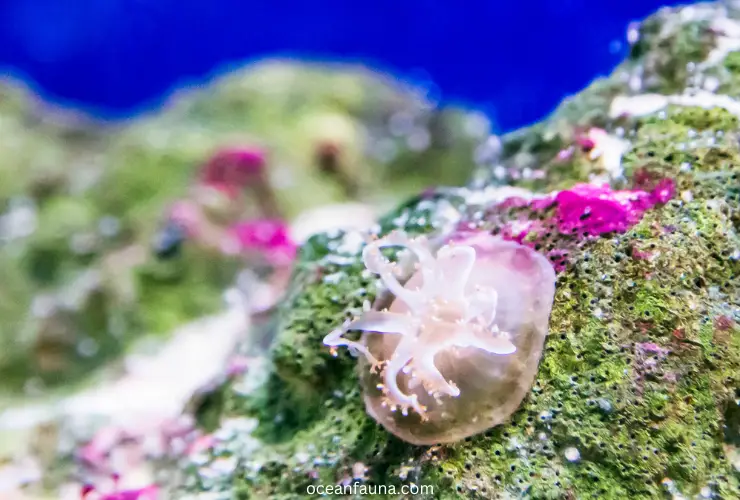
Relationship Between Upside-Down Jellyfish And Humans
Upside-down jellyfish have a complicated relationship with humans. They are not known to be harmful to humans. Their sting can cause discomfort and irritation. These jellyfish are sometimes kept in aquariums due to their unique appearance. It has led to concerns about their introduction into non-native habitats.
However, they can be beneficial to humans in other ways. The symbiotic relationship between the jellyfish and the algae makes them an important contributor to the marine food chain. Additionally, some researchers are studying the use of jellyfish-derived compounds for medical purposes.
In some cultures, upside-down jellyfish are also used in traditional medicine. However, monitoring the spread of upside-down jellyfish and avoiding disrupting their natural habitats is important. Human activities like pollution and habitat change can impact their population.
Do upside-down jellyfish sting? Does an upside-down jellyfish sting hurt?
Yes, upside-down jellyfish can sting. However, their sting is generally mild and not harmful to humans. They may experience mild skin irritation, similar to a rash when humans come into contact with stinging cells.
It can be uncomfortable but usually subsides within a few hours. The severity of the sting can vary depending on the following:
- Individual’s sensitivity to the venom
- The amount of contact with the jellyfish
While upside-down jellyfish can sting, their sting is not typically harmful or dangerous to humans. These jiggly marine animals are poisonous, but their severity of poison is not lethal and toxic as compared to other deadly sea jellies.
FAQs
Do jellyfish know when they are upside-down?
We know that jellyfish don’t have a central nervous system. So, they don’t have the same awareness or consciousness as humans. This means they don’t experience things like knowing whether they are right-side up or upside-down. These sea jellies rely on their sensory organs to detect changes in their environment, like light, temperature, and salinity.
They have a kind of “nerve net” that allows them to respond to their environment in basic ways. This includes responding to physical stimuli such as touch or changes in water flow. So, jellyfish may be able to sense whether they are upside down, but they don’t have a sense of orientation as humans do.
Are upside-down jellyfish rare?
Upside-down jellyfish are considered or declared rare. They are commonly found in shallow, warm waters throughout the Caribbean, Bermuda, and the western Atlantic Ocean. They are endangered or threatened because of the destruction of mangrove forests (their primary habitat).
They are often considered pests by fishermen and aquaculturists. It is because they can clog nets and tanks.
In recent years, there have been reports of the species expanding its range to other locations, such as the Mediterranean and Hawaiian waters.
However, it is thought that due to human activities and threatened ecosystems, these species become the most vulnerable of all jellyfish. Besides these, uncertain farming practices and coastal development declined their population.
Conclusion
And that’s a wrap on our crazy facts about the upside-down jellyfish. We have learned about its biography, living habits, facts, etc. Who knew these creatures could be so interesting and quirky? It shows that there is always something new to appreciate in nature. Keep on exploring the amazing world of these sea jellies!

